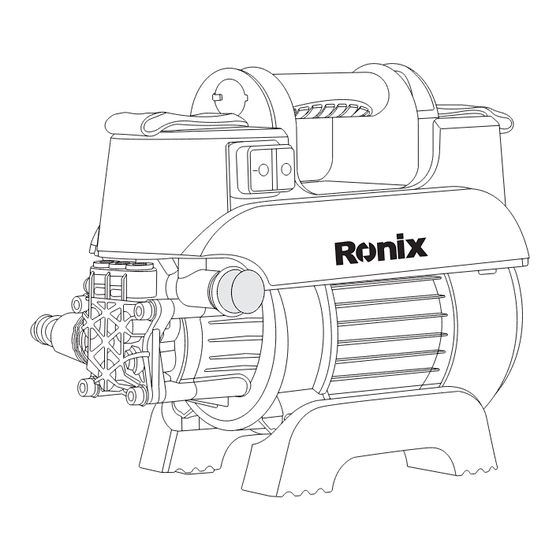
Table of Contents
Advertisement
Quick Links
Advertisement
Table of Contents

Summary of Contents for Ronix RP-0102C
- Page 1 HIGH PRESSURE WASHER RP-0102C...
-
Page 2: Parts List
50-60Hz Motor Type Motor Type Max Pressure 100Bar Max Flow Max Flow Weight 7.4KG Supplied in Ronix color box Quick connector Water inlet nut, Adjust- Includes able nozzle 5-meter high-pressure PVC hose, High-pressure gun PARTS LIST switch handle USER MANUAL... -
Page 3: Product Description
PRODUCT DESCRIPTION PURFPOSE - The high pressure cleaner is designed to clean vehicle, machines, buildings, facades, etc. in the private sector. AREAS OF APPLICATION - Never use the machine in potentially explosive areas under any cirummstances! - The operating temperature must be between 0 and +40˚C - The machine consists of an assembly with a pump, which is encased in a shock absorbing housing. - Page 4 Before starting up your machine please check it carefully for any defects. If you find any, do not start up your machine and contact your distributor. ESPECIALLY CHECK The insulation of the power cord should be faultless and with out any cracks. If the power cord is damaged, an authorized distributor should replace it.
- Page 5 - High pressure cleaners shall not be used by children or untrained personnel. - To ensure appliance safety, use only original spare parts from the manufacturer or approved by the manufacturer. WARNING! Water that has flown through backflow preventers is considered to be non-potable.
- Page 6 - If an extension cord is used, the plug and socket must be of watertight construction. - Inadequate extension cords and be dangerous. - Comply with the below-mentioned requirements for length and cored dimensions. 1.0mm max.12.5m 1.5mm max.20m 2.5mm max.30m - Power cord connections should be kept dry and off the ground.
-
Page 7: Mains Power Connection
MAINS POWER CONNECTION The following should be observed when connecting the high pressure washer to the electric installation: - The electric installation shall be made by a certified electrician and comply with IEC 60364. It is recommended that the electric supply to this appliance should include either a residual current device that will interrupt the supply if the leakage current to earth exceeds 30 mA for 30 ms. - Page 8 2. Connect the high pressure hose to the trigger gun. Connect the sliver end of the high-pressure hose to the trigger gun and twist the nut as indicated to secure the connection. 3. Connect the high-pressure hose to the water outlet Connect the other end of the high-pressure hose to the water outlet on the washer and twist the black rotatable end-piece as indicated to secure the connection.
-
Page 9: Operation
WARNING! The intake water temperature must not exceed 40. The water supply must not exceed 7 bar . CAUTION: The washer must only be used with clean water; use of unfiltered water of corrosive chemicals will damage the washer. - Push the motor switch to “OFF” position. Check the electrical supply voltage and frequency (Volt/Hz) correspond to those specified on the washer rating plate. - Page 10 CORRECT USE OF STANDARD ACCESSORIES - The washer is equipped with adjustable nozzle. - Jet adjustment from pencil to fan. WARNING! Do not adjust the nozzle while the triggter is squeezed. RECOMMENDED CLEANING PROCDURE - Dissolve dirt by applying detergent with the fan jet to the dry surface. On vertical surfaces.
-
Page 11: Maintenance
WARNING! BEFORE REUSING, COMPLETELY FLUSH THE UNIT OUT WISH PLAIN WATER. ANTI-FREEZE CAN DAMAGE PAINTWORK SO YOU MUST ENSURE THERE IS NO ANTI-FREEZE LEFT IN THE SYSTEM BEFORE USING IT AGAIN. MAINTENANCE CAUTION: Before working on the washer, disconnect the lug from the power supply socket. - Page 12 service organization. In case problems other than the above occur, please contact your local distributor. Symptom Cause Recommended Action - Machine not - Plug in machine plugged in - Try another socket Machine refuses to - Defective socket - Replace fuse start - Fuse has blown - Switch off other machine...









Need help?
Do you have a question about the RP-0102C and is the answer not in the manual?
Questions and answers